|
 GR and SP BASE LINES
GR and SP BASE LINES
The
two most common shale indicating logs are the gamma ray
(GR) and spontaneous potential (SP) logs. The units of measurement
for GR are API units or counts per second, and for SP are
millivolts. Density neutron separation is another common
visual method for visual analysis of shale volume.
Every log responds to shale in a particular way and each
shale bed has its own unique log response. Although log
readings in shale fluctuate from foot to foot, their average
values will be fairly constant over a large area of the
country.
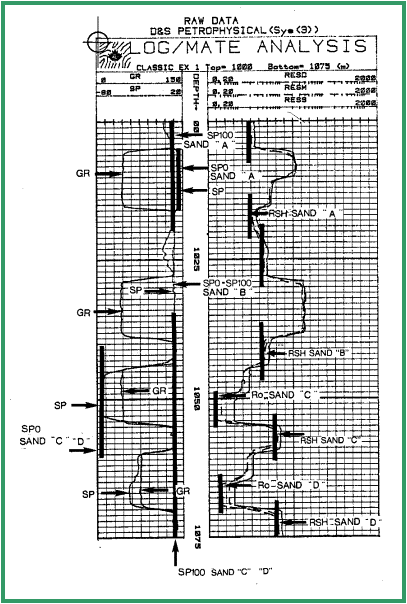 This
image illustrates the data for Classic Example 1, over clean
and shaly sands. A base line for the SP is shown on the
right hand side of the SP track. This line is called the
shale base line or the shale line (SPl00). This
image illustrates the data for Classic Example 1, over clean
and shaly sands. A base line for the SP is shown on the
right hand side of the SP track. This line is called the
shale base line or the shale line (SPl00).
The
SP deflects to the left in clean sand. In the cleanest sand,
the maximum SP reading to the left of the shale base line
represents the clean SP line (SP0). Note that other sands
may not develop an SP to the same degree as the cleanest
sand. Therefore, they are either shaly sands or else they
have fresher water in them. The proportion of shale can
be estimated by observing the actual SP deflection with
respect to the clean sand and shale base lines. For example,
the sand at 1060m has developed an SP of about 50% of the
maximum amplitude. Therefore, this zone is about 50% sand
and 50% shale.
This
is a rough approximation of shale content, but is often
the only source of shale information in shaly sands on older
logs where no gamma ray log exists.
SP
base lines generally drift to the left or right due to changing
electrical conditions at the well. Draw the base line to
conform to the drift. Measure the SP deflection between
the base line horizontally and not at right angles to the
base line. Most log analysis computer programs have a method
for correcting the SP drift. SP curves can also be normalized
to make the maximum and minimum deflections equal in all
wells by rescaling the curves in the computer. Some geological
information may be lost if normalization is performed -
some shaly sands may become too clean.
Note
that if mud filtrate is saltier than the formation water,
the SP shale base line will be on the left and the clean
line will be on the right. This is the reverse of the normal
situation.
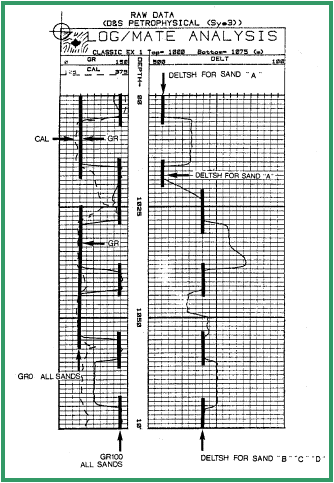 The
gamma ray, like the SP, has a shale base line and a clean
line. Estimation of shale content is done by observation
of the gamma ray log with respect to the clean line (GR0)
and the shale base line (GRl00). The base lines for the
GR are shown at the right. The
gamma ray, like the SP, has a shale base line and a clean
line. Estimation of shale content is done by observation
of the gamma ray log with respect to the clean line (GR0)
and the shale base line (GRl00). The base lines for the
GR are shown at the right.
GR
curves can also be normalized to make the maximum and minimum
deflections equal in all wells by rescaling the curves in
the computer. Some geological information may be lost if
normalization is performed - some shaly sands may become
too clean.
The
shale base line for both the gamma ray and SP may alter
with hole depth due to changes in logging instrumentation,
hole size, mud properties, and varying shale character.
Therefore, the shale base line should be chosen specifically
in the shales immediately below the formation of interest.
However, the clean line may have to be chosen quite some
distance from the zone of interest if no clean sands may
be nearby. If the well does not penetrate a shale below
the zone of interest, the shale base line must be chosen
from the nearest shale above the zone.
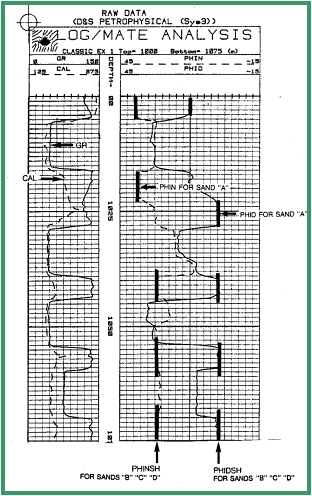 There
is no strong reason why the adjacent shales should represent
the shale properties within the shaly sand, but the assumption
is made that this is a good first approximation. Shale properties
may need to be adjusted by comparing shale volume calculated
from logs with core description, thin section point count
data, X-ray diffraction data, or scanning electron microscope
data. Discrepancies between log analysis porosity and core
porosity may also indicate that shale base lines need to
be adjusted. There
is no strong reason why the adjacent shales should represent
the shale properties within the shaly sand, but the assumption
is made that this is a good first approximation. Shale properties
may need to be adjusted by comparing shale volume calculated
from logs with core description, thin section point count
data, X-ray diffraction data, or scanning electron microscope
data. Discrepancies between log analysis porosity and core
porosity may also indicate that shale base lines need to
be adjusted.
The
gamma ray log is the most useful indicator of shale content,
with some minor exceptions, such as in radioactive sands
or radioactive dolomite. It is available on most wells logged
since 1957.
The
sonic log also has a shale base line (DELTSH). It is the
fairly straight section of the sonic log between l070 and
l075m in our example. Shale content cannot be estimated
elsewhere on the sonic log from this information alone.
This value must be known so that porosity calculated from
the sonic log can be corrected for shale. This is true also
of the density (PHIDSH), neutron (PHINSH) and resistivity
(RSH) logs, illustrated in Figures 6.01 and 6.03. It is
therefore, helpful to document these values over the entire
log interval for future reference.
 Scaling the SP and GR Logs in Shale Volume Units
Scaling the SP and GR Logs in Shale Volume Units
Having chosen the shale base line and the clean line for
either or both the SP and GR, you can scale logs in units
of shale content (Vsh). This is done by calling the clean
line 0.0 Vsh and the shale base line l.0 Vsh as shown
below.
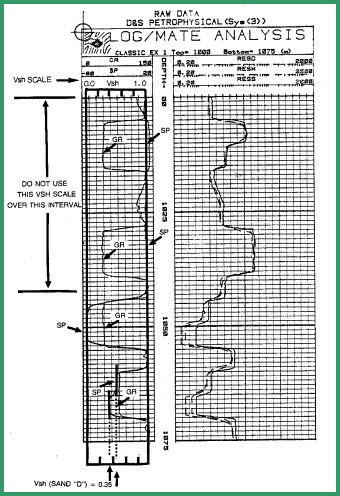 |
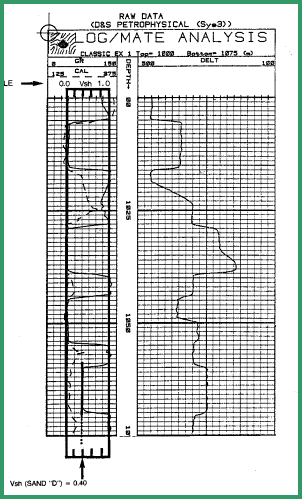 |
Shale Volume from SP |
Shale Volume from GR |
Then,
linearly interpolate a finer scale between the 0 and 1.0
points - such as the 0.0, 0.2, 0.4, 0.6, 0.8, 1.0 scale
shown in the examples. From this scale, the shale content
(Vsh) can be read for any point on the log. For example:
| |
Vsh
From GR |
Vsh
From SP |
| Sand
A: |
0.0 |
-0.1
(due to fresh water) |
| Sand
B: |
0.0 |
1.0
(due to fresh water) |
| Sand
C: |
0.0 |
0.0 |
| Sand
D: |
0.4
to 0.5 |
0.35
to 0.45 (varies due to hydrocarbon effect) |
|
The
values derived from the SP are unreasonable considering
the data available in two of the four zones. Therefore,
the values should be discarded, or new base lines picked,
as shown above, and better Vsh values estimated.
In this example, the SP resolution is too poor to be useful
in Sand A, and the water resistivity
versus filtrate resistivity contrast in Sand B prevents
the use of the SP here.
 Scaling the Density Neutron Separation in Shale Volume Units
Scaling the Density Neutron Separation in Shale Volume Units
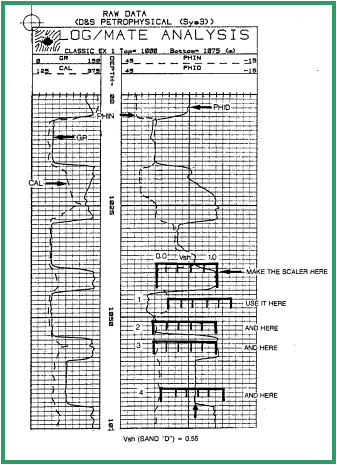
Similarly,
the separation between the density and neutron porosity
logs can be scaled in shale units, as shown at the left.
A scaler must be made equal in
length to the distance between PHINSH and PHIDSH. The scale
should be marked with 0.0 Vsh at PHINSH and 1.0 Vsh at the
PHIDSH point. Slide the zero end of the scaler along the
neutron log to read Vsh at each point desired.
|
Vsh
from Density Neutron
Separation
Point
1 Vsh = - 0.40 (due to gas
cross over or bad hole)
Point 2 Vsh = 0.00
Point 3 Vsh = 1.00
Point 4 Vsh = 0.55 |
If
this procedure is used in a shaly sand, the density neutron
log must be in sandstone units, and if used in a limestone
section, the log must be in limestone units. Do
not use this method in gas zones, dolomite, or anhydrite
sections.
 AN EXAMPLE FOR MORE PRACTICE
AN EXAMPLE FOR MORE PRACTICE
Crain’s Rule #0:
Gamma ray or SP deflections to the left indicate cleaner
sands, deflections to the right are shaly. Draw clean and
shale lines, then interpolate linearly between clean and
shale lines to visually estimate Shale Volume (Vsh).
 
Draw clean and shale lines (vertical black lines) and bed boundaries
(horizontal red lines). Estimate shale volume by linear
interpolation between clean and shale lines on SP and GR, and by
assessing the density neutron separation. Take the minimum
answer from these three methods as the final shale volume for
each layer.
In Layer A, the lowest Vsh on the SP
is 0.50 (marked on the log) and the average is about 0.60. On the
GR, the average Vsh = 0.65. The minimum is 0.60 on average. Layer B
shows about 0.05 on the SP and 0.00 on the GR - the minimum Vsh =
0.00. For Layer C, the SP gives 0.00 and the GR about 0.05 so Vsh =
0.00. Shale volume in the shale layer is 1.00 (100%) by definition.
Many "shales" are really shaly silts
or silty shales, so there may be reasons to move the 100% shale line
to the right of so-called "obvious shales" on the SP and GR logs.
Some radioactive zones are relatively clean sands or silts - check
the sample and core descriptions and get some X-Ray diffraction or
thin section point count data
to confirm the mineralogy.
|

